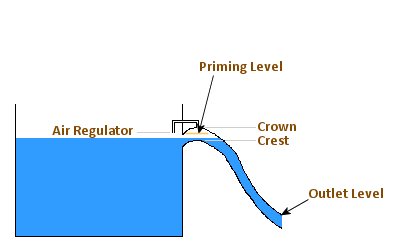Siphons
A siphon is an overflow structure that can consist of a single siphon tube or an array of identical siphon tubes. The siphon operates very like a weir structure when the water level is less than or equal to the siphon's Priming Level. Above this level the siphon operates, hydraulically, in a very similar way to an orifice located at the siphon outfall.

Plan view of an Array of Siphons

Siphon Cross Section showing levels

Schematic View of a Siphon Control in the Network
The Priming Level (or Air Regulator Level) must be between the Crown Level and Crest Level. When the average upstream water level is less than or equal to the Priming Level, the siphon operates as a weir.
When the average water level is greater than the Priming Level, the siphon is primed and flow is calculated as the lower of the flow values determined by the equations for the siphon operating as a weir and operating as a siphon.
Discharge Coefficients are entered for the siphon working as a siphon and working as a weir. These are used in the equations:
|
|
where: Q is the discharge N is the number of siphon tubes Cw is the discharge coefficient as a weir Cs is the discharge coefficient as a siphon W is the Width of the siphon tube h is the head over the siphon crest A is the area of opening. Area is the width multiplied by the height. Height is Crown Level - Crest Level. The siphon tube is assumed to be rectangular hd is the differential head. This is the water level upstream of the siphon minus the water level downstream |

Remember that most controls in an InfoWorks ICM network are treated as operating in the same way hydraulically for flow in both directions. This is obviously not appropriate for a siphon. It is up to you to avoid situations where such behaviour occurs in your network.
Villemonte Equation
The siphon is assumed to be under drowned weir conditions if the downstream water level exceeds the Crest Level and is below or equal to the Priming Level. If the Use Villemonte equation has been chosen as a Simulation Parameter, when the siphon is under drowned weir conditions, the Villemonte formula is used to modify the free discharge:
|
|
where: Q is the discharge Q0is the free discharge Du is the upstream depth with respect to the crest Dd is the downstream depth with respect to the crest |
Siphons and Weirs
Even though the siphon (when operating as a weir) behaves in the same way as a weir control with the same characteristics, the numbers you must enter are slightly different. The equation used for weir controls does not include the Ö2 term.
Therefore the discharge coefficient you enter must be x for a siphon and Ö2x for an identical weir control.
